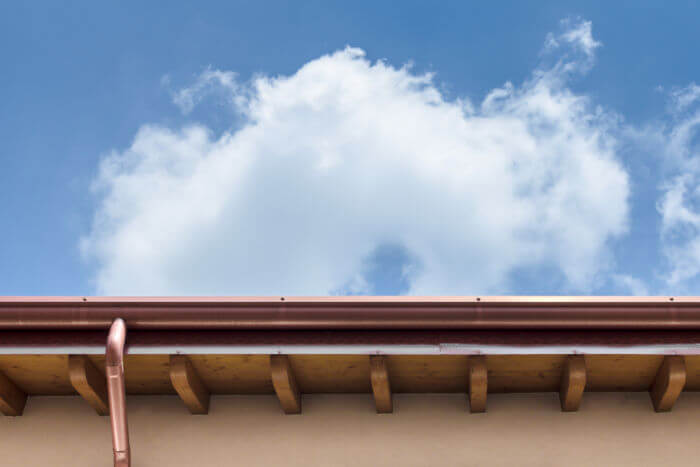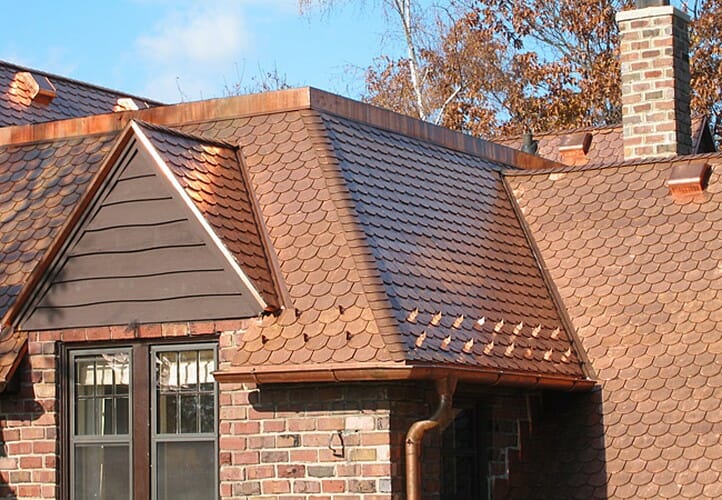Copper is used as a premium building material for several exterior areas of the home. It is used for gutters and downspouts, as well as flashing, fascia, soffits. It’s also a preferred roofing material for dramatic architectural roof features such as domes, spires and vaults. Many homeowners choose this type of gutters for their unmatched visual appeal and longevity. Copper gutters can last 100 years or more and can withstand the harshest weather conditions.
Modernize created this comprehensive guide to copper gutters to provide homeowners with helpful information on installation costs, styles, maintenance and the many benefits of using this building material. Read on to learn more about why copper gutters are a preferred option for high-end homes and how they can outperform other types of gutters.
Seamless Copper Gutters
Most copper rain gutters are seamless – they are formed into a continuous design from rolled copper stock, which helps eliminate leaking at joints. Sectional copper gutters, meanwhile, some in certain sectioned lengths, and all seams are soldered in place manually.

Gutter professionals recommend seamless gutters for all gutter replacement projects for the best durability and defense against the elements. Sectional gutters tend to be more prone to leaks and damage during inclement weather, which can lead to costly home water damage, clogged gutters, and other issues.
Especially if you are choosing a high-end type of gutters, it is within your best interest to protect your investment and install seamless gutters that are custom-fit to your home.
Benefits of Copper Gutters
Aluminum gutters are the most common type of gutters for U.S. homes. This is due to its cost compared to copper. That said, copper gutters provide a host of undeniable benefits that are hard to beat.
Curb appeal
Aesthetically, copper is in a class of its own. Copper rain gutters can be made in many different colors, with different coatings and textures. It also takes on a patina over time that can be a striking blue-green – like the Statue of Liberty – or a robust nut brown depending on how much moisture is in the atmosphere where you live. This patina is so desirable that copper manufacturers sell products featuring these enhanced colors.
Durability
Another benefit of copper is its unmatched longevity. Copper gutters can last as long as 100 years when properly maintained. This makes the investment well worth it. Once a homeowner installs this type of gutters, chances are they will never need to complete another gutter installation during their homeownership.
Copper gutters are also extremely corrosion resistant and are the most durable type of gutters when it comes to heavy rainfall or storms.
Sustainability
Copper is also a common choice for sustainable building systems since it’s 100-percent recyclable. It is naturally produced and long-lasting, and even acts as a natural algaecide and fungicide. This means cleaning and maintenance may be less than with other types of gutter materials.
Due to its high cost versus aluminum, however, copper gutters and downspouts are most commonly found in the luxury home market or on homes designed with classical or historical architectural features.

Styles of Copper Gutters
There are two main styles of copper gutters: half-round and K-style. K-style gutters are a bit less expensive than half-round copper gutter styles. Cost aside, each style has its benefits and drawbacks worth considering. Here’s a closer look at each.
K-Style Copper Gutters
K-style copper gutters are so named because the profile view looks like a capital letter “K.” The shape provides rigidity when the trough is filled with water. K-style copper gutters can be anywhere from 5” to 8” wide, but 5” and 6” are the most common gutter widths. This style of gutters is the most common for U.S. homes, but the pros and cons are worth considering.
Pros of k-style copper gutters
- K-style gutters can hold a lot of rainwater, especially in wider widths.
- The shape makes them easier to install. The flat back can be nailed directly to the roof fascia. This may cut down on installation costs.
- They can be quite attractive, a bit like having crown molding on your roof fascia.
- The rigid shape means greater durability and a longer lifespan.
Cons of k-style copper gutters
- They can accumulate debris, especially during storms.
- K-style gutters can be harder to clean. You will likely have to clean your gutters bi-annually.
- These gutters can retain some water due to their shape, which can lead to corrosion over time. However, corrosion is less of a problem with copper gutters compared to aluminum.
K-style gutters have a stylish appearance that works best with modern and contemporary architectural designs.Half Round Copper Gutters
Half round copper gutters – so named because they are shaped like a half circle – typically work best in historical architecture and older homes. However, they also work well for modern residences that do not have angular roofs. Though they are not as common as k-style gutters, it is worth noting their pros and cons.
Pros of half round copper gutters
- Rainwater flows more easily through the trough compared to k-style.
- Water will not collect and pool as easily, so half-round gutters are less prone to corrosion.
- Half round gutters tend to be easier to clean than k-style gutters.
Cons of half round copper gutters
- Half-round copper gutters can be more difficult to install.
- They carry a lower volume of rainwater compared to k-style. This means they may not be a good fit for areas prone to heavy rainfall.
- Availability can be limited since they are less popular than K-style gutters.
Choosing Gutter Guards for Copper Gutters
Gutters are essential for moving water away from your home and off your property to avoid water damage. Gutter guards provide essential protection to your gutters by eliminating debris buildup that can hamper efficient water flow through gutter troughs and downspouts. They can also help reduce routine maintenance and save you hours of weekend work. Most gutter professionals recommend gutter guards during any installation project.
Copper gutter guards are made to fit both half-round and K-style gutter profiles. They can be flat or have a gentle arching curve. Here’s a closer look at copper gutter guards options.
- K-style drop-in gutter guards. K-style copper gutter screens are the most economical option. They do not require any special hardware or fasteners; they have a reinforced front edge that grabs onto the gutter and locks it in place.
- Hinged K-style gutter guards. These gutter screens have clips that clamp onto the front edge of the gutter. They swing upward for easy trough cleaning.
- Half-round gutter guards. Just like hinged gutter guards, half-round gutter screens clamp onto the leading edge of the gutter and lift up to make cleaning the trough easier.
Copper gutter guard costs vary by product, quantity, and distributor. Professionals recommend not to use different metals, such as aluminum, on copper gutters because they can create galvanic or dissimilar metal corrosion. If you are on a budget, however, you can install plastic vinyl gutter guards.
Copper Gutter Maintenance
All gutters require routine maintenance to ensure they are free of debris and clogs, which can prevent water from flowing correctly to the downspouts. This is especially important for copper gutters, since built-up debris can tarnish its natural beauty and hurt your investment.
In addition to keeping the gutter troughs free of detritus, gutter maintenance can include regularly cleaning the outside of the gutter and downspout surfaces to keep your premium copper gutters looking as shiny and bright as the day they were installed. You can use a soft-bristled brush and a bit of dish soap for light cleaning, or a specialty mixture of 1-1 ratio flour to vinegar mixture for a deeper cleaning. This should be done at least twice a year – ideally once in the spring and once in the fall.
Regardless of your maintenance schedule, your copper gutters will take on a patina over time due to oxygen oxidation. Moisture, pollution, smoke from forest fires and other climate-related factors also can affect the visual appearance of your gutters. Note: Higher-quality copper is slower to show the effects of oxidation.


